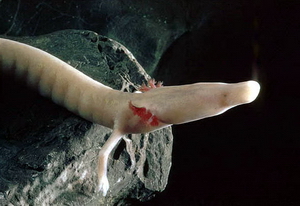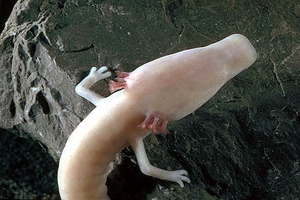Olm
Olm (Proteus anguinus) is a rare, aquatic salamander species found primarily in the cave systems of the Dinaric Alps, spanning from southeastern Europe across countries such as Slovenia, Croatia, and Bosnia and Herzegovina. Known for its pale, almost translucent skin and lack of eyes, the olm has adapted remarkably to life in complete darkness. This adaptation includes heightened senses of hearing, smell, and especially touch, which it uses to navigate and hunt in its subterranean aquatic environment.
Description[edit | edit source]
The olm is notable for its elongated body, which can reach up to 30 cm in length, making it one of the largest cave-dwelling animals. Its skin is covered in a layer of mucous, which aids in cutaneous respiration, a process that allows the olm to breathe through its skin in the oxygen-poor waters of its habitat. The lack of pigmentation gives the olm its characteristic ghostly appearance, while its reduced eyes are covered by a layer of skin, rendering the olm completely blind.
Habitat and Ecology[edit | edit source]
Olm habitats are characterized by cold, oxygen-rich water, typically found in limestone cave systems. These environments are nutrient-poor, which has led the olm to evolve a slow metabolism and a low reproductive rate. Olms are known to feed on small crustaceans and insects that are washed into their aquatic habitats. Remarkably, olms can survive for years without food, thanks to their efficient metabolism and low energy requirements.
Conservation Status[edit | edit source]
The olm is listed as a vulnerable species on the IUCN Red List due to its limited distribution and the specific conditions required for its habitat. Threats to its survival include pollution, habitat destruction, and the impacts of climate change, which can alter the delicate balance of its cave ecosystems. Conservation efforts are focused on habitat protection, pollution control, and research to better understand the needs and behaviors of this unique species.
Research and Significance[edit | edit source]
Scientific interest in the olm extends beyond its unusual appearance and adaptations. As a species that has lived in isolation for millions of years, the olm provides valuable insights into evolutionary biology, particularly regarding adaptation and speciation in cave environments. Additionally, its longevity and resistance to aging and cancer make it a subject of interest in biomedical research.
Cultural Impact[edit | edit source]
In the regions where it is found, the olm has become a symbol of natural heritage and biodiversity. Local folklore often features the olm, sometimes attributing to it mystical properties or seeing it as a harbinger of impending disasters. Its presence in the cultural and natural landscape of the Dinaric Alps underscores the importance of preserving these unique ecosystems.
Search WikiMD
Ad.Tired of being Overweight? Try W8MD's physician weight loss program.
Semaglutide (Ozempic / Wegovy and Tirzepatide (Mounjaro / Zepbound) available.
Advertise on WikiMD
|
WikiMD's Wellness Encyclopedia |
| Let Food Be Thy Medicine Medicine Thy Food - Hippocrates |
Translate this page: - East Asian
中文,
日本,
한국어,
South Asian
हिन्दी,
தமிழ்,
తెలుగు,
Urdu,
ಕನ್ನಡ,
Southeast Asian
Indonesian,
Vietnamese,
Thai,
မြန်မာဘာသာ,
বাংলা
European
español,
Deutsch,
français,
Greek,
português do Brasil,
polski,
română,
русский,
Nederlands,
norsk,
svenska,
suomi,
Italian
Middle Eastern & African
عربى,
Turkish,
Persian,
Hebrew,
Afrikaans,
isiZulu,
Kiswahili,
Other
Bulgarian,
Hungarian,
Czech,
Swedish,
മലയാളം,
मराठी,
ਪੰਜਾਬੀ,
ગુજરાતી,
Portuguese,
Ukrainian
Medical Disclaimer: WikiMD is not a substitute for professional medical advice. The information on WikiMD is provided as an information resource only, may be incorrect, outdated or misleading, and is not to be used or relied on for any diagnostic or treatment purposes. Please consult your health care provider before making any healthcare decisions or for guidance about a specific medical condition. WikiMD expressly disclaims responsibility, and shall have no liability, for any damages, loss, injury, or liability whatsoever suffered as a result of your reliance on the information contained in this site. By visiting this site you agree to the foregoing terms and conditions, which may from time to time be changed or supplemented by WikiMD. If you do not agree to the foregoing terms and conditions, you should not enter or use this site. See full disclaimer.
Credits:Most images are courtesy of Wikimedia commons, and templates, categories Wikipedia, licensed under CC BY SA or similar.
Contributors: Prab R. Tumpati, MD





